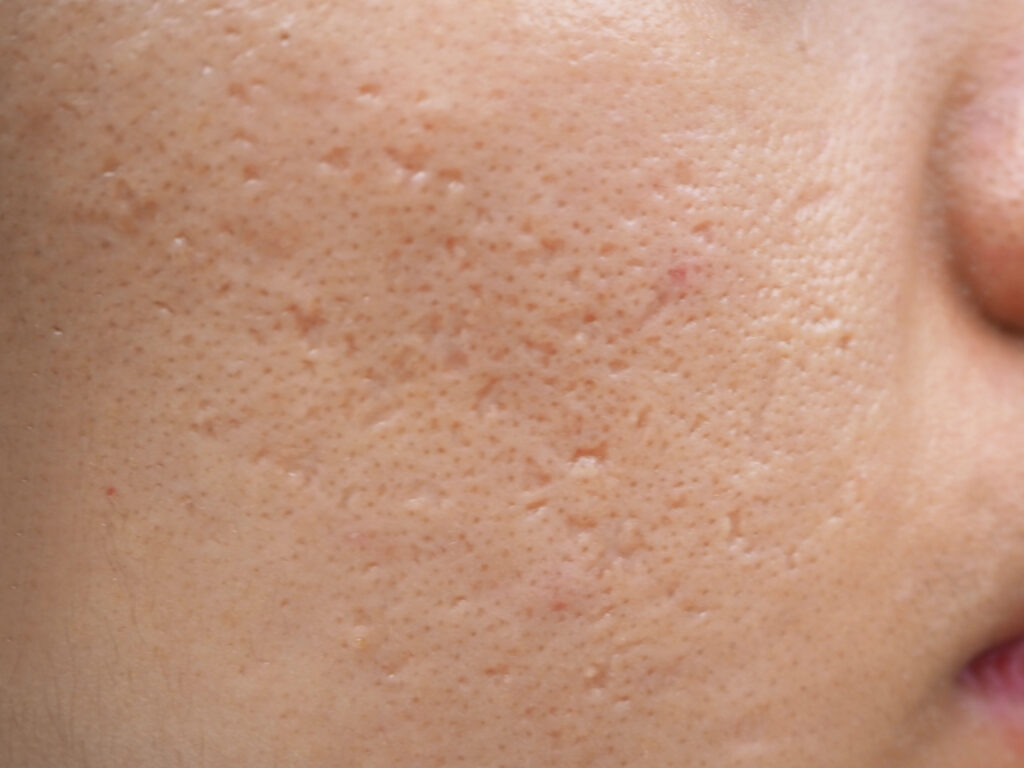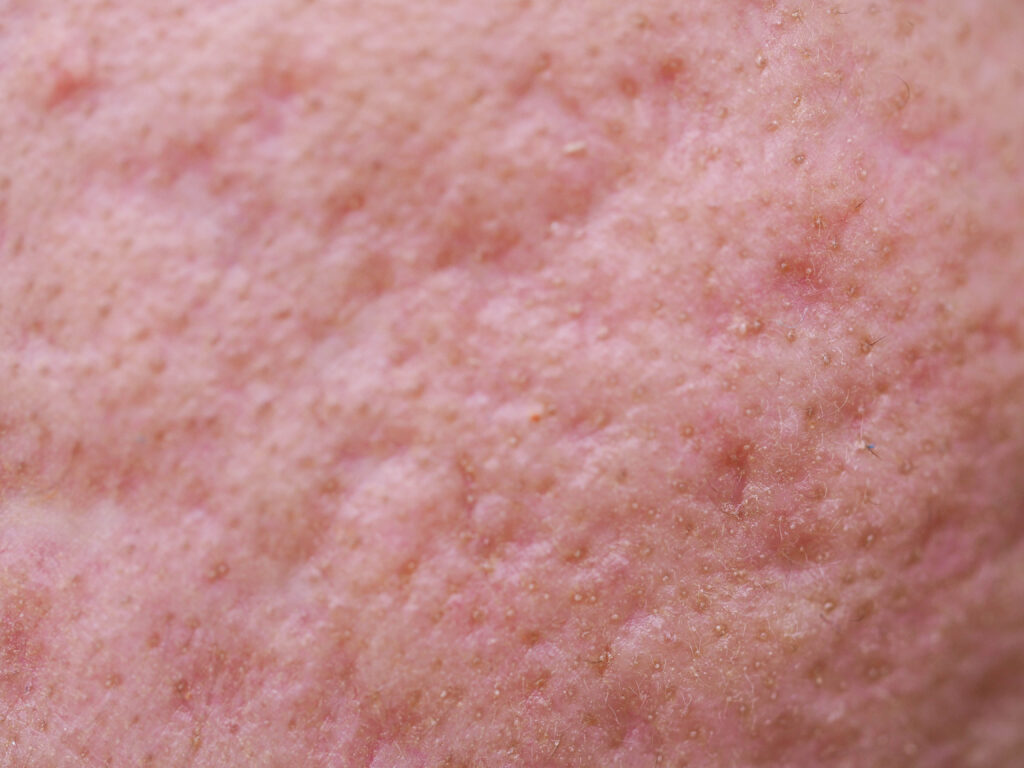10 Acne Scar Treatments Recommended By Top Dermatologist

Acne scars are a bummer. In other words, they are frustrating, and they can form at any time and take over your face. Since you are reading this, chances are that you are looking for solutions to get rid of acne scars. The good news is that there are ways you can treat acne scars to help them fade away more quickly. Read on for the 10 treatments recommended by Dr. Adebola Dele-Michael, one of NYC's top dermatologists!
Table of contents
Scars due to acne can lead to profound psychosocial impact
Acne vulgaris is a prevalent skin disorder. Acne is not life-threatening, however, it can be painful, embarrassing, and scarring due to acne can lead to long-lasting skin disfigurement and profound psychosocial impact.
Moreover, the bad news is that acne scars are difficult to treat; that's why I recommend visiting a board-certified dermatologist for early and effective acne treatment to prevent acne scarring.
The best acne scar removal treatments involve a customized treatment plan
The good news is that Dr. Dele-Michael specializes in treating acne scars in all skin tones. Over the years, she has helped many people regain their confidence by treating their acne scars. The best acne scar treatments involve a customized treatment plan based on the patient's desired treatment goals. This blog will share some of Dr. Dele-Michael's treatment approaches for the most common acne scars.
For example, micro-needling can help prevent future breakouts and improve skin texture. Similarly, non-ablative lasers can lighten dark spots and reduce the appearance of scars. Platelet-rich plasma can help to promote healing when there is an active breakout that needs healing as soon as possible so it won't leave deep scars behind after it's healed."
First, let us discuss some acne scar terminologies, so we are on the same page.
Types of acne scars
In this paragraph, I will discuss the types of acne scars. You can divide acne scars into two categories based on how they look. The two categories are atrophic scars and hypertrophic scars.
1. Atrophic scars
Atrophic scars are the most common type of acne scars. Atrophic scars are indented because acne inflammation destroyed the top layer of the skin. In addition, destructive inflammation in the deepest layer of the skin can lead to contractions, making the indents deeper and bound down.
There are three types of atrophic scars:


Ice picks scars have a small entry point with sharp steep edges; like a "V", for instance. In addition to icepicks scars in the picture above, note that there are also boxed car scars and rolling scars.
Interestingly, people often confuse icepick scars with enlarged pores but these are distinct entities that have very different treatment approaches. The former, ice pick scars, can be very challenging to treat, while the latter, enlarged pores, can be treated with creams and serums.
People often confuse icepick scars with enlarged pores, but these distinct entities have very different treatment approaches.

As opposed to icepick scars, boxed scars have a wider base, sharply demarcated borders; like a box. They can be shallow or deep.

In rolling scars, fibrous bands extending from the scar tether the skin down
2. Hypertrophic scars
In contrast to atrophic scars that are indented, hypertrophic scars happen when the skin builds up more scar tissue (collagen) to heal after the acne has resolved. A hypertrophic scar forms a firm, raised bump on the skin but does not go over the edge of where you had the original acne. Keloids happen when the skin builds up too much scar tissue (collagen), and they go past the edge of where you had your actual acne injury.
A person might have both atrophic scars and hypertrophic scars, for instance. People often have different atrophic scars (icepick and boxcar and rolling scars) simultaneously to make matters more interesting.
Acne scar stages and severity
Generally, the stage of your acne scars can help determine which treatment will work best for your acne scars.
Mild stage: Shallow scars that cover a small area and can be covered with makeup.
Moderate Stage: Deeper scars that cover a large area and cannot be covered with makeup.
Severe Stage: Deep scars that are on your skin and can't be covered by makeup, even if you try. They can't be flattened by stretching the skin.
Undoubtedly, acne scars are difficult to treat but, with the emergence of safe and effective lasers and energy devices, there is hope for people with acne scarring. Whereas some lasers work on the color of acne scars, others work on reducing the depth of the acne scar by building up collagen.
Some lasers work on the color of acne scars, and others work on reducing the depth of the acne scar by building up collagen.
How to get rid of acne scars
- Lasers
- Microneedling with Radiofrequency
- Dermal Fillers
- Subcision
- Punch excision
- Platelet Rich Plasma
- Chemical Peels
- Combination treatment
Lasers for acne scar treatment
Lasers for pigmented acne scars
1. Alma ClearLift QS 1064 nm
Alma ClearLift is highly effective for treating various degrees and depths of pigmented lesions. The high power Q-Switched Nd:YAG 1064 nm laser treats deep pigmented lesions.
- The procedure is safe on all skin types.
- It can make acne scars lighter
- There is no downtime.
- The procedure also reduces redness from inflamed acne and controls sebum production.
2. LaseMD, a 1927nm Thulium laser
Without a doubt, the LaseMD 1927nm Thulium Laser is a unique sub-ablative laser for targeting pigmentation, skin resurfacing and rejuvenating.
To explain, Sub-ablative means that the wavelength penetrates the upper dermis without causing the upper layer to peel. As opposed to an ablative laser that removes the top layer of the skin,
To achieve this goal, the laser's wavelength penetrates to a level between the lower part of the epidermis and dermis. It can target pigmentation, freckles, sunspots, age spots, and melasma while renewing damaged skin and stimulating collagen production.
In addition, this treatment combines pulses of photo-light energy to activate skin cells to improve scars/texture, increase collagen production, moisture levels in the skin, and improve skin tone.
- Pore tightening
- Skin brightening
- Firming and lifting
- Anti-wrinkle
- Stimulate collagen production
- Stimulate elastin production
Fractional Ablative lasers
Next up, fractional Ablative lasers remove damaged skin in a precise pinpoint pattern, resulting in collagen stimulation. Since only a fraction of the skin is treated with each treatment, a series of treatments is required to treat the entire affected surface.
3. Alma Pixel Er: YAG Laser
Alma Pixel Er: YAG provides a highly effective fractional ablative laser skin resurfacing treatment using a 2940 nm.
As a result, it improves overall skin tone, elasticity, and texture and reduces superficial pigmentation and pore size.
Also, the Advanced Fractional Erbium laser helps your acne scars go away with minimal downtime. This laser uses advanced technology to minimize downtime and increase patient safety. The laser also helps regenerate collagen in the skin for smoother, acne scar-free. The treatment interval is 4-6 weeks for acne scar removal. There is redness after the procedure, which lasts for 1-3 days.
Advantages of Acne Laser Treatments
As listed below, there are several advantages of laser and energy device treatments to remove acne scars.
- Laser skin resurfacing targets skin layer by layer with precision
- Lasers are powerful tools. For example, they can break the thick fibrous bands of scars and help to stimulate collagen, thus, effectively smoothing the skin.
- Lasers help to remove and lighten pigmented acne scars and prevent acne breakouts.
- Besides, laser treatments can help control the oil and sebum production and prevent future acne breakouts that can cause scar formation.
- Last but not least, lasers can tighten the skin while removing acne scars. Becasue laser treatments help to stimulate collagen, they can make the skin firmer and tighter while removing acne scars at the same time.
4. Micro-Needling with Radiofrequency (RF)
Compared to laser treatments, this is the clear winner for treating deep/stubborn acne scars that require more profound penetration into the acne scar and a more intense approach. Briefly, ultra-fine needles first penetrate the scar tissue and then emit radiofrequency (RF) energy to break up the scar tissue and stimulate collagen. Despite being more intense, there is minimal downtime of 1-3 days.
Also, microneedling with radiofrequency has decreased risk of scarring and infection when compared to ablative lasers. It can be safe to use in all skin types as it is chromophore-independent, unlike other energy-based modalities, such as CO2 laser.
The microneedling devices available at Dr. Dele-Michael's practice are the:
a. Morpheus8 by Inmode
b. Genius by Lutronic
Because of their robotic motor, which ensures maximum comfort while delivering microneedles at the desired depth, RF energy is delivered precisely to varying skin depths, giving these treatments exceptional outcomes.
Many columns of RF energy are emitted into the scars. The scars break up, and new collagen is deposited. New collagen deposition improves the skin texture and reduces the appearance of scar tissue
Micro-needling radiofrequency treatments are very safe on darker skin tones. So, there is a lower chance of post-inflammatory hyperpigmentation (PIH).
5. Dermal Fillers
In the past 10 years, many injectable dermal fillers have been approved for use in aesthetic dermatology. These include temporary, semi-permanent, and permanent fillers to help with scars. Superficial rolling or boxcar scars respond best to dermal fillers and can be combined with subcision for better results.
Some of the dermal fillers that Dr. Dele-Michael uses to treat acne scars are:
a. Hyaluronic acid: Juvederm, Restlane, Belotero, Versa
b. Calcium hydroxyapatite: Radiesse
6. Subcision
Subcision works best for rolling scars but it is less effective for deep boxcar scars and icepick scars. Furthermore, subcision is a simple surgical procedure using a hypodermic needle to release the bands of fibrous tissue holding down the skin in rolling scars. It is often combined with other treatments listed.
7. Punch excision
Punch excision is an excellent option for treating icepick and deep boxcar scars.
8. Chemical Peels
A chemical peel is a quick outpatient procedure that can be used to treat acne scarring. Mild acne lesions and shallow atrophic scars can respond well to superficial and medium depth peels, such as 20% to 35% TCA, alpha hydroxy acids, salicylic acid, and Jessner's solution.
More so, TCA Chemical reconstruction of skin scars (CROSS) has come into favor for icepick scars and deep box scars in recent years. In the CROSS method, high concentrations of TCA are applied on a sharp wooden applicator and then pressed firmly into the icepick scars, and white frosting is observed.
TCA Chemical reconstruction of skin scars (CROSS) has come into favor for icepick scars and deep box scars in recent years.
9. Platelet-Rich Plasma
Plasma-rich plasma (PRP) consists of preparing the patient's own blood and concentrating its platelets, growth factors, and cytokines in plasma to promote wound healing.
Combining PRP with Fractional Ablative Lasers and Microneedling with radiofrequency can promote slightly faster healing and clinical improvement.
10. Combination treatment
Finally, since most people have more than one type of scars, a combination treatment approach can offer excellent results in a shorter amount of time. Laser treatments can be combined with dermal fillers or PRP, for instance.




Leave a comment